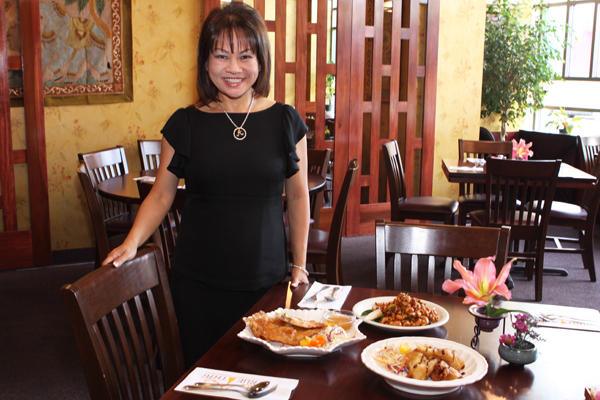
Editor’s Note, 10.27.13: True Thai is now closed.
Anna Prasomphol Fieser is indefatigable. By day, she is employed at the Ramsey County Department of Health; By night, she runs True Thai, the popular Seward restaurant. Yet she still finds time to work out for two hours a day and update her blog, posting thoughtfully written essays about everything from the proper way to peel a banana to the difference between red, green, and yellow curry and how, as a teenager, she came to be the Bishop Samanchit’s chili sauce maker.
The woman is tiny, she’s over-worked by anyone’s standards, but at the end of a long week she seems to have more energy than a 2-year-old after a dozen powdered donuts. Her face is incredibly expressive — indeed, her whole wiggling and gesticulating person communicates a kind of contagious energy and enthusiasm for food, people, Kaffir limes, just about everything she touches.
For all that charm, she also claims shyness. When the Heavy Table called for an interview, she agreed only on the condition that we do the interview via e-mail; we haggled and got the second interview in person. What follows is an amalgamation of the two, during which she talks about growing up in a family of cooks, the difficulty of importing authentic ingredients, and the transformative powers of Thai food eaten every waking hour of the day.
I’ve really enjoyed reading your blog, which is a mix of personal and food history, life, and ingredients. How has the blog changed your relationship with diners?
I have found blogging to be addictive. Not the blogging so much as the conversations it starts with my customers.
Now every night customers come in and greet me by name. Just last night two customers came in and wanted to have their picture taken with me. Before I went to bed last night, that picture was on their Facebook page! But more important to me, it was their 49th wedding anniversary, and they chose to share that occasion with us even though they’d never been to our restaurant before, and had just learned about us through my blog.
Because of the blog, we get about 10 customers a night who don’t want to see the menu but instead just ask me what I had for dinner, and that’s what they want, too. I’m inspired by customers who trust us like that; I think they feel emotionally connected to the restaurant.
Do readers interact with the blog? For example, did you get any takers on the shout-out for vegetarians to help design some meatless menu items?
Yes. We had three responses to that post, including one customer who brought us two kinds of fake meat to try. I was very touched by his helpfulness, but I think we’ll stick with tofu and mock duck for now.
We were not looking to change our recipes. That post was about the difficulty of accurately communicating to our customers what’s in each dish. We are still working on that, but so long as we have one or two new servers on the staff, there will always be problems if vegetarians do not ask for me personally to help them make the appropriate menu selections.
On the blog, you talk about different sources for recipes and the influential cooking women in your life — your mom, great-grandmother, and Aunt Lam. Did your mom cook for a living or for the family?
For the family and for people. And then some of the relatives actually own restaurants — we sell, we cater the food.
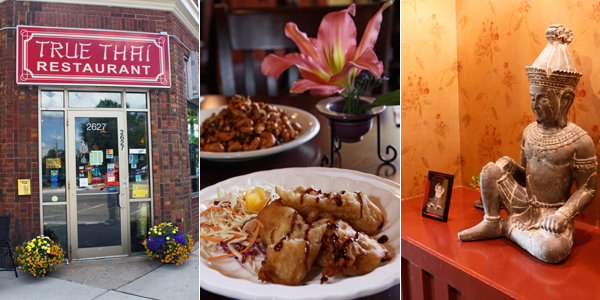
Thailand is sort of famous for its vendors, who apparently sell all kinds of ingenious food from street-side carts. Is that how your mom sold her food?
My great-grandmother, my grandmother, my aunt, my mom; they all were street vendors. They made fried bananas, all kinds of desserts, salads, pad thai, and curry.
So, how does that work? Is it a time of day, like the farmers market or meal times or all day? It must be really competitive.
Yes, all day. That’s why the Thai people are so slim; they eat all day. And you know something about being a street vendor, you don’t sell many, many things, you sell your best. There are lots of people on the street, so to get people’s attention, you have your own specialty.
So what was, say, your great-grandmother’s most famous dish?
Fried bananas — Anna’s fried bananas, now. Mom would make pad thai, curries, and salads. When we talk about salad in Thailand it is a meal. See, if it is a served at room temperature, we call it salad, even though it is an entrée. So, Laab on our menu is a meat or tofu dish and served with rice, but we call it a salad.
Did your mom actively teach you to cook, or did you learn from being in that environment?
Well, we had no TV at all growing up. My dad owned a movie theater, but he didn’t allow me to go watch movies. The only time that I’d get to go see a movie — even though it was free — was after exams. Even then I had to have a note from my dad to show at the theater, “Let me in!”
So, all the time I had available, my mom said, “Either you come help me and learn how to cook or you go study French after school.” And, after being in school all day, I didn’t want to do anymore reading or studying, so I had no choice.
And she called that a bonding time – just me and her. Also, being a girl growing up with eight brothers in the household, you may think, oh, maybe they will be more nurturing with me, but no; they were very rough. So, in order to please them… maybe they will be less mean to me if I make them something delicious.
What was their favorite dish?
The favorite would be a stir-fry, just anything that was spicy — all kinds. We had 12 in the family, so she’d make at least 10 dishes. That’s two hours of cooking, so starting at 3 o’clock until 5pm – me and her.
So your mother was literally cooking all day in order to have food to sell and to feed the family?
Yes. Getting up in the morning at 4am, cooking all day, coming home …
On the blog you also talk about how your family is Vietnamese-Thai — How did that influence the way you and your mom prepared Thai dishes?
Americans make a big deal out of hyphenating themselves. I guess you could say my family was Vietnamese-Thai, but we thought of ourselves as being very Thai. Like second-generation Americans, my mom and dad worked to be more Thai than Thai who could trace their ancestry back through the centuries.
But sometimes I’d travel to Bangkok and I wouldn’t see the food that I saw being cooked at home by my mom and relatives. I’d explain, Oh my mom makes… and they would have no idea.
My brothers liked Thai food more, but my mom would sometimes throw in Vietnamese so they’d remember.
So, were your parents refugees?
Yes, you could say that, but not in the 1970s, this is way back, the first set of refugees.
Did they come as a community or alone?
Eight families. They walked from Vietnam together and then they kind of inter-married; you had to be married to people from these original families. It’s not that way anymore, but back then, my mom had to marry within this community.
So, when you were a kid, it was still a close-knit community?
It still is now. Like, this is so funny: When I went home the last time, the church bell rang a certain way, a ring that tells the people someone has died. This very slow ring – I had forgotten that sound completely. So if there was a death in the family, we would run over to the church, within 10 minutes, and ring the bell to let the community know.
Growing up in that community and knowing that your parents had that experience, has that informed the choices you’ve made about your career — working at both the restaurant and as a public health nurse?
Well, yeah, it’s all about helping people, pleasing people. That’s my, I don’t know, you can say weakness. Even as a restaurant, we just want to please people.
I have read that Thai restaurants have made their food sweeter and less hot for the American palate. This doesn’t seem to be true of your food, which might shock people who think of Minnesotans as hot-dish eaters. When you opened in 2002, were Minnesotans immediately open to the complex heat and intensity of your seasonings?
Ever since I came to the Twin Cities, in 1990, I have been meeting Minnesotans who love hot food. There is more competition for their business now, but there are also more hot food lovers here than there used to be. I am very proud of the fact that True Thai is popular with East Indians, who love our curries. We are also seeing more and more Hispanic customers who have learned that Thai food is reliably spicy.
What is the difference between East Indian, Thai, and Mexican spicy?
Okay, the East Indian, they use a lot of ground, dry curry and, I don’t want to put anyone down, but to me Mexican is less complex, it’s more like two flavors, there is a flat flavor and then there is the spice of the pepper.
But for Thai, you need four flavors: sweet, sour, salt, and spice to create that intensity.
How have your customers changed – if at all, over the last six or seven years?
A lot. People are more open; they are willing to try anything we make. We have a lot of repeat customers, who say, “Come on, Anna, we want to try something new.” I have somebody growing vegetables for me, so they will pick whatever is fresh that day. Yesterday, they picked about five pounds of snap pea tips — that’s the leaves. So when a loyal customer came in and says, “What do you have that’s fresh today?” I ask, “How spicy do you want it?” and stir fry the pea tip leaves — I just make something. They are willing to try it.
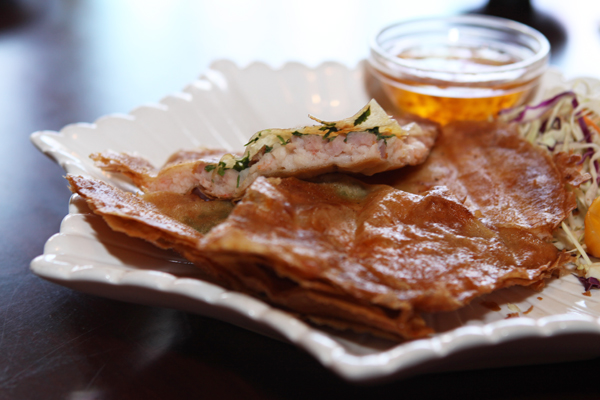
Anything you’ve tried to introduce that completely flopped?
Our most expensive appetizer, the Golden Wheel of Shrimp & Ham Delight, has never been a big seller (above).
Why is that, you think?
I don’t know — It’s delicious! Will you try it? Many friends also warned me that our Thai Omelet wouldn’t go over well because Minnesotans only eat eggs for breakfast. We learned that Minnesotans will eat eggs and potatoes any time of day.
Are you currently working on any experiments?
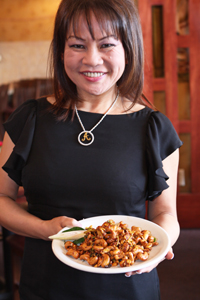
Yes. Tom Yum cashews (photo at right). Roasted galanga root, lemon grass and Kaffir lime leaves. It reminds me of Muay Thai boxing matches, as my mom served these ingredients and cashews to boxers before their matches.
Do the ingredients have special properties that enhance boxing ability?
I don’t know, protein maybe? All of the ingredients have medicinal properties, but it’s only my family, really… this is not nationwide. My dad was the promoter for the boxers – you know like the Don King of Thailand – and before the fight my mom would make these.
I had forgotten about this recipe until recently, when I read about Trader Joe’s Chewy Crisp Tom Yum Cashews. I did not think they were very good, but they reminded me a little bit of my mom’s cashews and I have a cook who is currently “reinventing” them for possible inclusion on our menu.
Has it been difficult to match the flavors of home with Minnesota or US herbs?
We use as much locally grown produce as possible. In Chanthaburi, where I am from, seafood is very popular because we are next to the sea. Obviously, True Thai cannot serve fresh seafood, at least not without charging Oceanaire prices, but we buy as much locally as possible. Our walleye and our catfish are local.
Mostly we work very hard to get authentic ingredients. Yes, most of our mangoes come from South America, but essential ingredients like galanga, lemongrass, jasmine white rice, Thai eggplant, etc., come to us from Thailand; although more and more of these things are being grown in the United States.
Kaffir lime leaves, for example, are now grown in Florida and California.
You pay as much as $3 apiece for a Kaffir lime. The skin is wrinkled; I peel it off and throw away the fruit. One time, I ordered $2,000 worth of imported lime, at that time it was from Thailand. We had just opened, and we had Mexican prep cooks peeling the Kaffir limes. They’d never seen them before, and you know what they did: They threw away the peel and kept the fruit! OH! That’s the most expensive lesson!
What do you think sets True Thai’s flavors apart from other Thai restaurants?
That commitment to serving Thai-style food. Before True Thai opened, no one served Thai eggplant because it was expensive and hard to get. The better Thai restaurants had some ingredients shipped from Thailand, but that became much harder after 9/11.
For a while we were using an import broker to deal with the very complicated post-9/11 import laws. We had one entire shipment destroyed by customs because of these rules. That was very sad.
Were you also affected by Hurricane Katrina?
Yes, so now it is not worth it for me to order Kaffir lime leaves from Thailand. So then we tried to order them from Florida, but because of Katrina the entire crop was wiped out.
In fact, right now I have nine Kaffir lime trees at my house. My sister has a PhD in soil science and has been working at the University of Minnesota in their soil-testing lab. My other sister is retired and living back in Thailand, so I got her to send some seeds that I could sow. We started them in the soil at the University. They are doing very well.
How big are they — bushes or trees?
It has been seven years. So really, they are 9- or 10-feet tall. One day I will put them on the blog so people can see them. I can’t bring them here because the few that I’ve bought are worth $500 a piece. It’s that much. In the winter, the leaves alone are $40 a pound.
How many leaves do you use in a day?
We use five pounds a day. My plants won’t produce fruit because I keep picking the leaves. But I don’t know if they would produce fruit anyway because they need sun all year.
Are there any current food trends that inspire you?
For two years before True Thai opened, I visited every new restaurant that opened in the Twin Cities. What you call “inspiration” some might call “stealing,” but many things at True Thai were inspired by other local restaurants. In turn, True Thai now inspires many other restaurants.
It is this kind of competition that has improved Twin Cities’ Thai restaurants, just as it does in Thailand. Like I said, people are so willing to try everything that everything is kind of a hit. Palace Style Wontons, that was my own creation.
What inspired that?
Everyone loves that tangy Pad Thai sauce, so I thought I should do something else with it. And I needed a crunchy appetizer. I put a pen and paper under my pillow, sometimes I have dreams about food and I wake up and write them down. So people say, Oh, Anna you are working in your sleep, but not really because I have to have REM sleep to get there — so sometimes it comes in my sleep or driving.
It’s off topic a little, but what are you doing for the Department of Health? How do you balance the restaurant with nursing ?
As a public health nurse it is my job to work with Southeast Asian clients, mostly teen mothers. I was hired for this job one day after I mailed my resume to Ramsey County. In 1994, I believe I was the only person in Minnesota with a nursing license who spoke Hmong. At least I was the only person with those qualifications who applied for the job!
Now it would be easy for the county to replace me because there are so many good Hmong-American nurses to pick from. I know because many of them keep asking me when I am going to retire!
It is easy to balance the two jobs. All day long I am a public health nurse. After 5pm and on weekends I am a restaurant owner.
You are remarkably energetic for someone who works day and night. How do you do it — Tom Yum cashews?
Oh my gosh – how? Maybe I shouldn’t tell you this, but six months ago I was 40 pounds heavier. Before, I ate everything, but now I eat every hour and exclusively here. I go to the gym for two hours a day, run 5 miles a day, and lift weights.
I’ve always been an energetic person, but now I have more. I wake up with energy; I go to bed with energy.
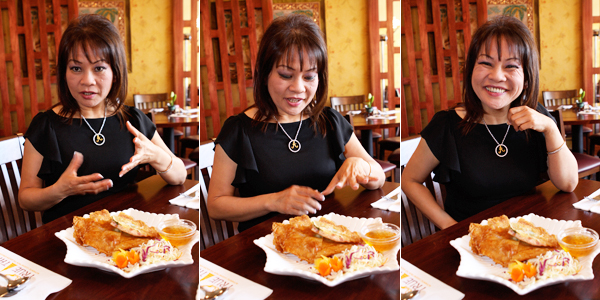

Another great read about life in Longfellow. This is a GREAT restaurant, run by amazing people!
Anna—you are amazing. You are an inspiration. I have known you for at least 5 years now and I learned so much more from this interview! True Thai is a GREAT RESTAURANT! My very best wishes for continued happiness and success.
A great article about a fantastic restaurant and most impressive restauranteur. People who once thought I was a tasteless clod now see me as an epicurean cognoscente after taking them to True Thai. Truly, both the restaurant and Ms. Fieser are wonderful. The corn fritters? Killer.
What a fantastic interview. I learned so much about Anna that I didn’t know. True Thai is truly a wonderful restaurant. Along with great food and a relaxing atmosphere, Anna’s personality, energy and generosity set True Thai apart. Some of my favorites include the corn cakes, the crispy catfish salad, and the Red Curry with Kabocha Squash.
This is a beautiful interview that tells beautiful stories about a beautiful person and the beautiful restaurant she offers to the world. Anna’s generosity and genuine love for those who partake of the outstanding food at True Thai permeate the place in a remarkable way. From the food on your plate to the smiles on the faces of all the servers, chefs, and staff, you will be immersed in positive energy from the moment you enter Anna’s realm. You can’t find a menu item that isn’t delicious, but do yourself a favor and make sure at least once to try my favorite, #40 – the rainbow medley of seven vegetables. It is the dish that will make you forget forever the idea that healthy food, aesthetically pleasing food, and food that makes you drool can’t all be one and the same.